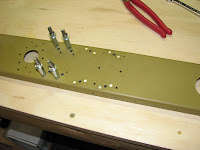


I didn't have much time tonight but I wanted to at least understand if I needed to do any trimming on these hinge stop tubes for the Stabilator - this is where I left the shop yesterday. So, before doing any trimming to blindly follow the manual and the requested 21/32" +1/32" -0" length, I
took a closer look at how Van wants me to
finally attach the Stabilator to the fuselage.
As the manuals explicitly asked to leave the shape and the angle of the hinge brackets alone and some of the shorter tubes fit just perfectly, I was wondering if I really have to go through a trimming process that would then violate this explicit request.
The question was, what has to fit in between those hinge brackets when the Stabilator is attached to the fuselage and will it fit with the shorter tubes as well?
The answer to this question is on page 10-04 and it shows the bearing VA-146 which will be placed in between those hinge brackets. A first test showed that there must something else as it had way too much room in there. So looking a bit further on page 10-05 I found the callout for the additional mounting hardware: AN960-416 or -416L as needed between the bearing sides and the brackets. I tried two -416L with the shorter tubes and I could just get it in. No leeway but the bearing moves freely. This tells me that the length is just fine and I will not do anything with the shorter ones. The other bracket turned out to be a tick wider and I needed a -416L and a -416 to get the same tight but tension-free fit. Here I will trim down the tubes a bit to make them slide just in, but that was not a job for tonight.
So, the insight that I gained is that sometimes it makes sense to take a closer look at why Van's wants you to do something in a certain way and there might be a bit of freedom once you understand what it is. Well, if you goof up it was certainly your own fault though and not Van's. A risk that I'm going to take in this case.
Well, that's all nice and good but what about the Epiphany I hinted to in the title?
Hm, it's a bit hard for me to admit that - even to myself, so not to mention to you! The thing is, I am building way too fast! I don't think this is owed to my outstanding engineering or metal working skills but more to the fact that the RV-12 kit is simply amazing in terms of precision as well as the level of pre-manufacturing. It is almost like putting together a Lego set
If you scroll back a month you'll see that I just starting to build the airplane in early May and now the Empennage is almost done and the tail cone won't take very long either. My cautious estimate of completion of this subkit is end of July - IF I continue at this pace. And you might have already noticed that I slowed down a little. This was partly due to the heat but partly also to this Epiphany I had.
So, what am I going to do when there's no parts left on this subkit and the next subkit (the wings) is not going to arrive before end of September - and that implies that Van's is not going to delay the delivery which is not too improbable.
Well, I am pretty concerned about losing my rhythm in the build process as I've seen what this can cause with other builders and I might not be immune to this. The threat is that once you've lost your rhythm you fall into a phase of putting it off, doing other things and so on and even when you get the parts you were waiting for you might not be able to easily get back to your previous build schedule.
My conclusion is that I'd rather slow down now while I would like to go faster and try to keep that drive but spend less time in the shop anyway. This is pretty easy as it is frickin' hot in there and anything more than two hours is seriously painful.
Throwing in a little bit of flying, working around the house and doing other nice things will keep me busy and somehow stay in some kind of rhythm of which I think it might be easier to switch back to all airplane building once the wing kit arrives.
Let's see if this works out ...
















































